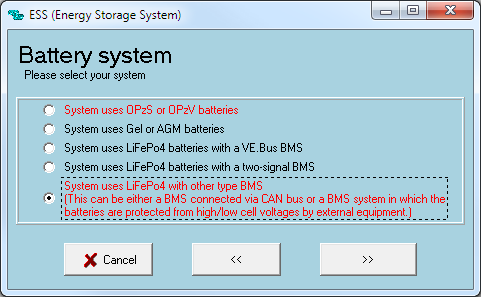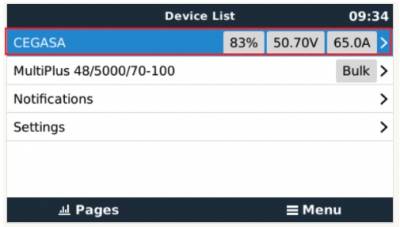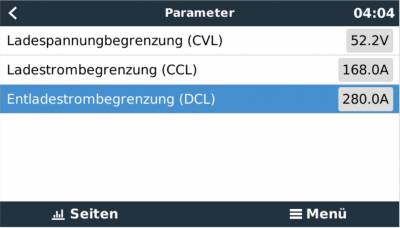Table of Contents
Victron & Cegasa
1. Product & System compatibility
1.1 Offgrid, Backup and Energy Storage Systems (ESS)
Victron + Cegasa eBick can be used for the following system types:
- Energy Storage Systems - Self Consumption (ESS - Start page)
- Grid Backup
- Off-grid
Special note for Off-Grid systems
For Off-grid systems, its strongly recommend to make sure there is a minimum of DC-Coupled PV (= MPPT Solar Charger) in the system. Ie. not only AC-Coupled PV. Also, minimum battery configuration, and factor 1.0 are always important to adhere to, and even more so in case of Off-grid systems. Both Cegasa and Victron will be reluctant or even refusing to give support to systems that are not sized according to the minimum battery configuration table.
1.2 A GX device is required, eg Cerbo GX
It is essential to use the BMS-Can connection of a GX device with the Cegasa batteries for the communication of charge and discharge limits, error codes and state of charge.
When used with Cegasa batteries, the minimum supported firmware version for the GX device is v2.22. It is recommended to use the latest firmware version on new installations and when troubleshooting issues.
Using a CCGX is not recommended as it only has a single VE.Can port.
1.3 All 48V Multis, MultiPlusses, MultiGrids, Quattros and RS models are compatible
The minimum supported firmware version is 469. Updating to the latest firmware is recommended for new installations, and troubleshooting issues.
These inverter/charger units must be connected to the GX device via the VE.Bus connection port.
1.4 Solar Charger compatibility
All current model 48V BlueSolar, SmartSolar VE.Direct, MPPT RS solar chargers are compatible.
Some of our Solar Chargers feature a VE.Direct communication port, some feature a VE.Can communication port, and some feature both. Both of these types of communication ports can be used to connect the Solar charger to the GX Device. Such connection is mandatory, because it is used to regulate charge currents and voltages.
When planning to use the VE.Can communications port to connect the Solar Charger(s), make sure to select a GX Device that has sufficient CAN-Bus ports. The Color Control GX has only one such port, its VE.Can port, and is therefor not suitable. All other GX Devices can be used, since they have two ports. One can then be used to connect the Cegasa battery, and the other to connect the Solar Charger.
1.5 Battery compatibility
The following batteries are supported:
| Cegasa series type |
|---|
| EBick LV |
The EBick LV has an external BMS (MCS master box) which connects to the Victron GX device.
Victron is not compatible with the Cegasa high voltage configuration where battery voltage is increased beyond 48V nominal. The Cegasa eBick 280 Pro product documentation mentions up 2-3 MWh capacity, this is due to the ability of the eBick 280 Pro to be able to be installed in series as well as parallel, HOWEVER Victron systems do NOT support the series connection configuration, hence the lower max 18 module capacity limit.
See the Cegasa manuals for more details.
2. Minimum Battery Sizing
The following information is provided by Cegasa, it is reproduced here for your convenience and should always be confirmed with the latest Cegasa manuals and specifications.
Each Cegasa eBick battery module is 13.5 kWh, approximately 280Ah at 48V (52.2V maximum).
The allowable charge and discharge rates are managed automatically by the Cegasa BMS and GX device. Temperature effects on charge rates should be considered in the design stage in hot and cold climates.
Using very large solar arrays with battery banks that are too small can exceed the limits of the batteries ability to charge and possibly lead to the BMS triggering over-current alarms, and system shutdowns.
The table below shows the minimum number of battery modules required for the specified inverter/charger configuration in normal conditions.
Battery Modules Required - Ebick LV
| Phases | Single Phase | Three Phase | Single Phase | Three Phase |
| Inverter/Charger | ESS | ESS | Off-grid | Off-grid |
| Multiplus & Multiplus II & MP-II GX 48/3000/35 | 1 | 1 | 1 | 2 |
| Multiplus & Multiplus II & MP-II GX 48/5000/70 | 1 | 2 | 1 | 2 |
| Inverter RS & Multi RS 48/6000 | 1 | - | 1 | - |
| Quattro 48/5000/70-100/100 | 1 | 2 | 1 | 2 |
| Quattro 48/8000/110-100/100 | 1 | 3 | 1 | 3 |
| Quattro 48/10000/140- 100/100 | 1 | 3 | 2 | 4 |
| Quattro 48/15000/200- 100/100 | 2 | 6 | 2 | 6 |
| EasySolar & EasySolar-II 48/3000/35-50 MPPT | 1 | 1 | 1 | 2 |
| EasySolar 48/5000/70-100 MPPT | 1 | 2 | 1 | 2 |
3. CAN-Bus wiring between the battery and GX Device
Step 1: Configure inverter type in the Cegasa BMS via Cegasa EViewer WebApp - See Cegasa documentation for details. Step 2: Connect normal CAT5e or CAT6 network cable (*) between the Cegasa BMS and the BMS-Can port of the GX device Step 3: Connect VE.Can terminator (supplied with GX device) to the other BMS-Can port of the GX device Step 4: Power on the GX device, and verify proper configuration and connection by checking that the battery shows up in the GX device menus.
(*) The specially wired type A or type B Victron BMS cables are NOT used with the Cegasa BMS.
4. VEConfigure settings
This section presumes familiarity with VEConfigure software.
4.1 General tab
- Check the “Enable battery monitor” function
- Set the battery capacity to the total capacity of the battery: eg 280Ah times the number of battery modules
- Charge Efficiency to 95%
- The other parameters (“State of charge when bulk finished”) can be left to their default setting.
4.2 Charge parameters
In normal operation with DVCC operational, the charge parameters are controlled by the BMS and communicated through the system by the GX device to the inverter/charger and MPPT. However as a precaution it is advised to set these as suggested below.
Charger tab
| VEConfigure Charge Parameter | Setting |
|---|---|
| Battery type | Lithium |
| Charge curve | Adaptive |
| Absorption voltage | 52.2 V |
| Float voltage (1) | 52 V |
| Absorption time | 8 Hr |
| Charge Current | 140A per battery module |
If you use any assistants after programming these settings, make sure to double check the float voltage after completing them, and if necessary set it back to 52 V.
4.3 Inverter Settings
In the Inverter tab of VEConfigure
| VEConfigure Inverter Parameter | Setting |
|---|---|
| DC input low shut-down | 44V |
| DC input low restart | 48V |
| DC input low pre-alarm* | 45V |
* The pre-alarm setting is dependant on your preference and on site specific requirements. You may wish for this to be activated earlier in an off grid situation to allow time to start a backup generator. If the system is configured in ESS mode, you may not wish to have this alarm trigger until below the Sustain threshold voltage, as this system is in no danger normally and will 'sustain' without needing to trigger an alarm.
ESS System Settings
If you are using the battery as part of a grid connected ESS system, please review the ESS Quickstart guide and Design and Installation Manual.
The settings that are specific to the Cegasa battery in the VEConfigure ESS Assistant are below:
Select the externally managed Lithium battery option

| ESS Parameter | Settings |
|---|---|
| Battery Capacity | 280 Ah |
| Sustain voltage. | 50V |
| Dynamic cut-off values | Voltage |
| 0.05 | 46V |
| 0.2 | 44V |
| 0.7 | 43.5V |
| 2 | 42.5V |
| Restart offset: | 1.2 V (Default) |
5. GX device configuration
When the Cegasa battery is connected to the BMS-Can port of a GX device (running v2.90 and later) the following DVCC settings will be set and enforced automatically.
If you are running a GX firmware version prior to this, these will need to be manually configured.
Manual Configuration
On the GX device,
Go to menu path: Settings → Services → CAN-profile.
Select the CAN-bus BMS (500 kbit/s) CAN-profile in the GX device.
Go to menu path: Settings → DVCC
| Venus Settings | Value |
|---|---|
| DVCC | ON |
| Shared Voltage Sense | OFF |
| Shared Temperature Sense | OFF |
2. After properly wiring and setting up, the battery will be visible as a battery in the device list:
 (if you have multiple batteries a single entry will show up, which represents all batteries).
(if you have multiple batteries a single entry will show up, which represents all batteries).
Confirm Connection
Confirm the parameters option within the battery page shows the actual battery charge and discharge limits. In normal working conditions, the discharge current limit (DCL) is ~140 A per module. For example, 280A charge current limit (CCL) ( 280 / 140 = 2 ) means there are 2 Cegasa battery cells connected.
Reporting of additional cell level details (e.g. Lowest and Highest cell voltages etc) to the GX device is not currently supported.
GX Device with multiple CAN-bus port configuration
With GX devices that have two CAN-bus interfaces available (eg Cerbo GX and Venus GX), the VE.Can MPPT will remain connected to the VE.Can port, while the BMS cable should use the specific BMS-Can.
This allows data from the MPPT and battery simultaneously.
Color Control GX Configuration - Not Recommended
The CCGX only has one available VE.Can interface. It is not possible to connect both CAN products such as VE.Can MPPT (250 kbit/s) and a Cegasa battery BMS-Can CAN-bus (500 kbit/s) together on the CCGX. As the Battery MUST be connected, you will need to use the port for that. This will mean no data is collected from the VE.Can MPPT, nor can the CCGX control it, so they cannnot be used.
For this reason it is recommended to use the Cerbo GX instead.
6. Solar Charging
6.1 Victron MPPT charger settings
Victron MPPT charge characteristics are automatically configured & governed by the GX device. The settings below are a precautionary measure only:
| MPPT Parameter | Setting |
|---|---|
| Battery voltage | 48V |
| Maximum Charge current | 50A per battery module |
| Absorption voltage | 52V |
| Floating Voltage | 51.8V |
Use VictronConnect for Solar Charger configuration.
6.2 Self-Startup from Low voltage shutdown modes
In a correctly configured system, the inverter will shut itself down before the batteries enter a self protective shut down state.
Therefore it is essential that there is also either a generator or DC MPPT charge controller for overall system stability. If your system is charged only with an AC-coupled PV inverter, this may prevent the AC-coupled PV inverter from starting up to recharge the batteries.
Even a single 100/20 48V MPPT charger unit with 2 x 60 cell solar panels would be sufficient to add this self correcting mechanism able to maintain the DC bus voltage and improve longterm system reliability considerably from accidental deep discharge and subsequent shut down.
7. Troubleshooting
If the system is not operating correctly, go through these steps.
Step 1. If the Inverter/Charger or GX device does not switch on
Low voltage and deeply discharged behaviour
When the grid is connected there are two software controls to sustain voltage. The Minimum SOC (while grid is connected) set in the GX device, and the sustain voltage (set in the ESS assistant).
If the grid fails and no AC supply is available, in this deeply discharged state, and the battery has set the Discharge Current Limit (DCL) to 0A, then the inverter will turn off in a software off state.
The GX device will remain on, as there is still DC voltage provided by the batteries for a while.
Note in this state an AC PV inverter will not produce any power, and will not start up, as it requires the inverter to create the sine wave to synchronise.
If the AC grid or generator, or DC MPPT is connected, then the battery will begin to charge and then the inverter will start itself again automatically, also resuming charge from an AC PV inverter.
If instead the battery becomes completely discharged the battery will further protect itself by not just sending the 0A discharge limit, but also disconnecting DC voltage from the battery terminals (via internal MOSFETS). As there is no DC voltage available on the terminals any more the GX device will also shut down, and the inverter will also then be hard off (not just software off).
If you then reconnect a DC charge source, or AC input supply (grid or generator), after approximately 2 minutes the inverter will start up again, power the DC bus, powering up the GX device, and then powering up the battery, and the system will recover.
Step 2. Check that the battery is visible on the GX device list
If its not visible, check:
- GX device firmware version (update to latest version, v2.90 or later)
- CAN-bus communication cabling between Battery and Victron system.
Step 3. Check that the battery is ready for use
Check the Max Charge Voltage parameter. This voltage parameter is sent, together with the other three parameters, by the Cagasa system via the CAN-bus cable. They are visible on the GX device: Device List → battery → Parameters menu.
When ready for use, the Max Charge Voltage will read 52.2 V.
Also check that your are seeing the expected discharge current per installed module.
8. Known Issues with Cegesa models
There are no known issues with the Cegasa battery modules, however previous issues have been addressed in firmware updates, so please make sure you are running the most recently available version before investigating other causes.
9. Cold Weather Performance
The Cegasa cells will limit the charge current allowed at lower temperatures.
| Temperature (Celsius) | Charge Current Limit |
|---|---|
| Under 0 degrees C | 0C |
| 0-10 degrees C | 0.2-0.3C |
| 11-46 degrees C | 0.5C |
| 47-65 degrees C | 0.3C |
| Over 65 degrees C | 0C |
Note an additional limitation applies at the start and the end of the charge cycle - see product documentation for more details.
Keep your batteries in a climate controlled environment as close to 20 degrees celsius as possible for best performance. Depending on your climate, consider insulation and reverse cycle air-conditioning to prevent issues in hot and cold weather.
Cells will also heat themselves up when charged and discharged.
10. Further Information
For information about where to buy or find suitably qualified installers, visit the Where to Buy Page.
Further community discussion about installing and using Cegasa and Victron can found at Victron Community, use the topic label 'Cegasa'.
 Add this page to your book
Add this page to your book  Remove this page from your book
Remove this page from your book  Manage book (
Manage book ( Help
Help 
